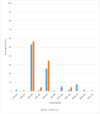The prevalence of molecular markers of resistance to sulfadoxine-pyrimethamine among pregnant women at first antenatal clinic attendance and delivery in the forest-savannah area of Ghana
- PMID: 35939419
- PMCID: PMC9359546
- DOI: 10.1371/journal.pone.0271489
The prevalence of molecular markers of resistance to sulfadoxine-pyrimethamine among pregnant women at first antenatal clinic attendance and delivery in the forest-savannah area of Ghana
Abstract
Intermittent preventive treatment during pregnancy with sulfadoxine-pyrimethamine (IPTp-SP) is used to prevent malaria and associated unfavorable maternal and foetal outcomes in pregnancy in moderate to high malaria transmission areas. Effectiveness of IPTp-SP is, however, threatened by mutations in the Plasmodium falciparum dihydrofolate reductase (Pfdhfr) and dihydropteroate synthase (Pfdhps) genes which confer resistance to pyrimethamine and sulfadoxine, respectively. This study determined the prevalence of molecular markers of SP resistance among pregnant women in a high malaria transmission area in the forest-savannah area of Ghana. Genomic DNA was extracted from 286 P. falciparum-positive dried blood spots obtained from pregnant women aged ≥18 years (255 at first Antenatal Care (ANC) clinic visit and 31 at delivery from 2017 to 2019) using Chelex 100. Mutations in Pfdhfr and Pfdhps genes were detected using molecular inversion probes and next generation sequencing. In the Pfdhfr gene, single nucleotide polymorphisms (SNPs) were detected in 83.1% (157/189), 92.0% (173/188) and 91.0% (171/188) at codons 51, 59, and 108 respectively in samples collected at first ANC visit, while SNPs were detected in 96.6 (28/29), 96.6% (28/29) and 96.8% (30/31) in isolates collected at delivery. The Pfdhfr triple mutant N51I, C59R and S108N (IRN) was carried by 80.5% (128/159) and 96.5% (28/29) of the typed isolates collected at ANC visit and at delivery respectively. In the Pfdhps gene, SNPs were detected in 0.6% (1/174), 76.2% (138/181), 33.2% (60/181), 1.2% (2/174), 0% (0/183), and 16.6% (27/173) at codons 431, 436, 437, 540, 581 and 613 respectively in samples collected at ANC, and 0% (0/25), 72% (18/25), 40% (10/25), 3.6% (1/25), 0% (0/29) and 7.4% (2/27) in samples collected at delivery. Quadruple mutant Pfdhfr N51I, C59R, and S108N + Pfdhps A437G (IRN-GK) was present in 25.8% (33/128) and 34.8% (8/23) of isolates at ANC and at delivery respectively. Quintuple mutant alleles Pfdhfr N51I, C59R, and S108N + Pfdhps A437G and K540E (IRN-GE) were detected in 0.8% (1/128) and 4.4% (1/23) of samples collected at ANC and at delivery respectively. No mutations were identified at Pfdhfr codons 16 or 164 or Pfdhps 581. There is a high prevalence of Pfdhfr triple mutant P. falciparum infections among pregnant women in the study area. However, prevalence of the combined Pfdhfr/Pfdhps quadruple and quintuple mutants IRN-GK and IRN-GE respectively prior to commencement of IPTp-SP were low, and no Pfdhps A581G mutant was detected, indicating that SP is still likely to be efficacious for IPTp-SP in the forest-savannah area in the middle belt of Ghana.
Conflict of interest statement
The authors have declared that no competing interests exist.
Figures
Similar articles
-
Low prevalence of highly sulfadoxine-resistant dihydropteroate synthase alleles in Plasmodium falciparum isolates in Benin.Malar J. 2021 Feb 5;20(1):72. doi: 10.1186/s12936-021-03605-5. Malar J. 2021. PMID: 33546703 Free PMC article.
-
Analysis of sulphadoxine-pyrimethamine resistance-associated mutations in Plasmodium falciparum isolates obtained from asymptomatic pregnant women in Ogun State, Southwest Nigeria.Infect Genet Evol. 2020 Nov;85:104503. doi: 10.1016/j.meegid.2020.104503. Epub 2020 Aug 15. Infect Genet Evol. 2020. PMID: 32805431
-
Prevalence of Plasmodium falciparum parasites resistant to sulfadoxine/pyrimethamine in pregnant women in Yaoundé, Cameroon: emergence of highly resistant pfdhfr/pfdhps alleles.J Antimicrob Chemother. 2015 Sep;70(9):2566-71. doi: 10.1093/jac/dkv160. Epub 2015 Jun 16. J Antimicrob Chemother. 2015. PMID: 26080363
-
Evolution of Pfdhps and Pfdhfr mutations before and after adopting seasonal malaria chemoprevention in Nanoro, Burkina Faso.Sci Rep. 2024 Oct 16;14(1):24224. doi: 10.1038/s41598-024-75369-2. Sci Rep. 2024. PMID: 39414909 Free PMC article.
-
Prevention of malaria in pregnancy.Lancet Infect Dis. 2018 Apr;18(4):e119-e132. doi: 10.1016/S1473-3099(18)30064-1. Epub 2018 Jan 31. Lancet Infect Dis. 2018. PMID: 29395997 Review.
Cited by
-
Prevalence of molecular markers of sulfadoxine-pyrimethamine resistance in Plasmodium falciparum isolates from West Africa during 2012-2022.Sci Rep. 2024 Nov 4;14(1):26567. doi: 10.1038/s41598-024-75828-w. Sci Rep. 2024. PMID: 39496624 Free PMC article.
-
Plasmodium falciparum drug resistance-associated mutations in isolates from children living in endemic areas of Burkina Faso.Malar J. 2023 Jul 20;22(1):213. doi: 10.1186/s12936-023-04645-9. Malar J. 2023. PMID: 37474966 Free PMC article.
References
-
- World Health Organization. World malaria report 2021. 2021. https://www.who.int/teams/global-malaria-programme/reports/world-malaria....
-
- World Health Organization. WHO policy brief for the implementation of intermittent preventive treatment of malaria in pregnancy using sulfadoxine-pyrimethamine (IPTp-SP). Geneva: World Health Organization. 2013. https://www.who.int/publications/i/item/WHO-HTM-GMP-2014.4.
-
- Walker PG, Floyd J, Ter Kuile F, Cairns M. Estimated impact on birth weight of scaling up intermittent preventive treatment of malaria in pregnancy given sulphadoxine-pyrimethamine resistance in Africa: A mathematical model. PLoS medicine. 2017;14(2):e1002243. doi: 10.1371/journal.pmed.1002243 - DOI - PMC - PubMed
Publication types
MeSH terms
Substances
Grants and funding
LinkOut - more resources
Full Text Sources


